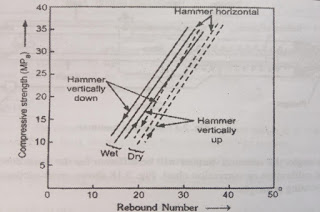Rebound Hammer Test as per IS 13311(part-2)-1992.
Rebound hammer test is a non-destructive concrete test which takes place to give the quality of concrete without damaging the concrete structure. It measures the elastic rebound of concrete and is used for determination of concrete strength.
This test is conducted by Schmitt rebound hammer which carries a driving spring, a release button, casing, a plunger, a spring controlled hammer, tabular housing, mass and a scale.
These units are arranged within a body such that when plunger hit the concrete surface, the mass rebounds from the plunger and the distance travelled by the mass gives the rebound number.
This test can be conducted horizontally, vertically, upwards or downwards or at any intermediate angle.
Procedure for rebound hammer test -
Before starting the procedure, calibration of the hammer is required.
- The surface of concrete is cleaned.
- The hammer is held at right angle to concrete surface structure.
- After holding hammer in position, the plunger is made to hit the concrete surface with impact energy.
- After pushing plunger towards the concrete surface, it rebounds back and shows a reading in a graduated scale which is noted as rebound number.
- 5-6 readings of rebound number are measured.The mean of these number is taken as rebound index.
- After finding the rebound index, the value is calculated with the compressive strength by using graph.





Comments
Post a Comment